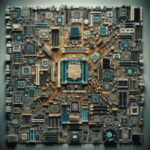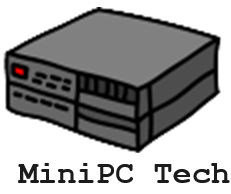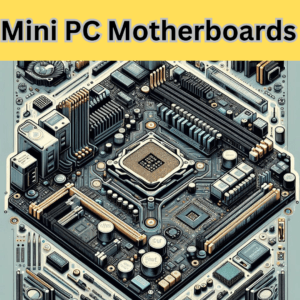
Selecting the right motherboard for mini PCs is a vital step in ensuring your compact computer runs smoothly and efficiently. At its core, the motherboard acts as the central hub. Mini PC motherboards act to connect all of your computer’s components. It contains the processor, memory, and interface hardware. This key piece of hardware determines compatibility. It plays a significant role in the performance and capabilities of mini PCs.
Key Takeaways
- Form Factor Matters: The choice of motherboard form factor directly impacts your choices. You need to consider mini PC’s size, capabilities, and expansion options. From ATX to Pico-ITX, each form factor caters to different needs, balancing performance with compactness.
- Features for Future-Proofing: Pay attention to features like CPU socket compatibility, RAM capacity, and expansion slots. This is crucial for ensuring your system can meet both current and future computing needs.
- Efficiency and Cooling: Consider the power consumption and cooling requirements of your chosen motherboard. This is especially important in compact builds. You need this to maintain optimal performance and longevity of your mini PC.
- Tailored to Your Needs: Selecting a motherboard involves understanding your specific requirements. This is true whether for gaming, professional use, or everyday computing. Then you need to balance these against the constraints of space and budget.
With various form factors like Mini-ITX, Nano-ITX, and Pico-ITX, it is important to understand role of the motherboard in Mini PCs. Choosing the right one is crucial for tailoring your computing experience to your needs, whether for gaming, work, or everyday use.
Understanding Mini PC Motherboards: Form Factors
Choosing mini PC motherboards starts with understanding the variety of form factors available. Each form factor isn’t just about the size. Each form factor influences compatibility and performance. Finally, it is influenced by the purpose of your mini PC build.
This overview aims to guide readers through the critical aspects of selecting a motherboard. It balances size, performance, and other factors to meet specific needs. This is important regardless of your goals. Whether you’re building a compact media center, a portable gaming machine, or a powerhouse workstation.
The table provided below offers a concise comparison of various motherboard form factors. Each form factor is evaluated based on key characteristics that are crucial for anyone planning a PC build. This is especially important for those considering mini PCs.
Dimensions are listed to give a sense of physical size. Physical size directly impacts the potential applications and placement of the final build. Ideal use cases suggest where each motherboard type excels.
Use cases vary. They include:
- embedded applications
- IoT devices
- high-end gaming
- professional workstations
Expansion capabilities indicate the potential for adding components like GPUs and extra RAM. This is vital for users planning upgrades or needing high performance.
The performance level provides insight into what tasks the motherboard is suited for.
Power consumption and cooling considerations highlight the practical aspects of building and maintaining a system with each motherboard type. This addresses how much energy they draw, and the strategies required to manage heat effectively.
| Form Factor | Dimensions (inches) | Ideal Use Cases | Expansion Capabilities | Performance Level | Power Consumption | Cooling Considerations |
|---|---|---|---|---|---|---|
| Mini-ITX | 6.7 x 6.7 | Compact PCs, media centers, small office/home office (SOHO) | Limited (1 PCIe slot, 2 RAM slots) | High for size | Low to moderate | Moderate; limited space for cooling |
| Nano-ITX | 4.7 x 4.7 | Embedded applications, digital signage, compact consumer electronics | Very limited | Moderate for embedded tasks | Low | Low; efficient thermal design required |
| Pico-ITX | 3.9 x 2.8 | IoT devices, wearable technology, handheld devices | Minimal | Low; basic computing tasks | Very low | Minimal; passive cooling often used |
| ATX | 12 x 9.6 | Gaming rigs, workstations, servers | High (multiple PCIe and RAM slots) | Very high | Moderate to high | Significant; ample space for advanced cooling |
| Micro-ATX | 9.6 x 9.6 | Budget-friendly PCs, compact yet expandable builds | Moderate (fewer PCIe and RAM slots than ATX) | High | Moderate | Moderate; space for good airflow and cooling |
| E-ATX | 12 x 13+ | High-end gaming, professional content creation, high performance computing | Very high | Highest | High | Extensive; space for multiple fans/radiators |
| XL-ATX | 13.6 x 10.4+ | Extreme gaming, multi-GPU setups, showcase PCs | Maximum | Extreme | High | Maximum; designed for elaborate cooling systems |
Consider options that fit snugly into small living spaces. Tradeoff with slightly larger choices that offer more expansion capabilities. The right form factor can make or break your computing experience. This section will explore the different types of motherboard form factors. It sheds light on their significance and helping you make an informed decision for your mini PC project.
Key Features to Consider When Choosing Mini PC Motherboards
Selecting the right motherboard is a pivotal decision in the journey of building a mini PC. It determines not only the size of your build but also its capabilities, performance, and potential for future upgrades. Various key features need to be taken into account to ensure that the motherboard aligns with your specific needs and use cases. These vary from form factor to expansion options, and power requirements to cooling solutions. Each aspect plays a crucial role in shaping the functionality and efficiency of your mini PC. Here, we’ll discuss these critical features. We will also provide examples across different form factors to illustrate their significance in your motherboard selection process.
The table below summarizes these criteria to help guide your decision-making process.
| Criteria | Importance |
|---|---|
| CPU Socket Compatibility | Ensures support for desired processors, affecting performance and future flexibility. |
| RAM Capacity and Speed | Influences multitasking and application performance; crucial for system responsiveness. |
| Expansion Slots and Ports | Determines system’s expandability and connectivity; more slots and ports offer greater flexibility. |
| Integrated Components | Integrated audio, network, and graphics can save space and cost, ideal for compact setups. |
| Power Consumption and Cooling | Affects energy efficiency and system stability; essential for maintaining performance in compact spaces. |
CPU Socket Compatibility
The CPU socket on a motherboard determines which processors it can support. This directly impacts the system’s overall performance and capability. Selecting a motherboard with the right socket is crucial for future flexibility and compatibility with desired CPUs.
For example, Mini-ITX motherboards designed for AMD’s AM4 socket can support a wide range of Ryzen processors. This compatibility is essential for builders looking to create compact yet powerful gaming PCs or workstations, offering both performance and efficiency within a small footprint.
RAM Capacity and Speed
RAM capacity and speed affect your system’s ability to multitask and handle intensive applications. Motherboards vary in the number and type of RAM slots. This influences future upgradeability and performance potential.
For example, standard Mini-ITX board might support up to 32GB of RAM at high speeds. This is ideal for users needing a balance between compact size and the capability to handle demanding tasks like gaming or video editing.
Expansion Slots and Ports
The availability of expansion slots and ports determines how you can grow your system and connect various devices. Additional slots and ports offer more flexibility. However, they can also increase the motherboard’s size and cost.
For example, micro-ATX motherboards generally provide more PCIe slots than their Mini-ITX counterparts. Thus, allowing for extra graphics cards or storage solutions. This feature makes Micro-ATX an excellent choice for users requiring greater expandability for tasks such as video editing, despite the slightly higher cost compared to Mini-ITX boards.
Integrated Components
Motherboards come with various integrated components, such as audio, network, and graphics capabilities. Integrated components can save space and cost. Thus, eliminating the need for additional expansion cards.
For example, nano-ITX boards often include integrated graphics and networking features. This caters to embedded applications and compact devices where minimizing additional expansions is a priority. This integration suits applications like digital signage. Applications where space and efficiency are paramount.
Power Consumption and Cooling Solutions
The power consumption of a motherboard and its components influences the overall energy efficiency of a system. On the other hand, cooling solutions are critical for maintaining performance and stability.
For example, pico-ITX motherboards have minimal power draw and compact size. This requires innovative cooling strategies due to limited space for traditional cooling systems. This consideration is crucial for embedded systems or portable applications. In these applications, power efficiency and the ability to manage heat in confined spaces are essential.
Selecting Mini PC Motherboards for Your Needs
When embarking on the journey to select from the choices among mini PC motherboards, you need to find one tailored to your specific needs. Let’s integrate the insights from the previously discussed criteria. Exploring the diverse range of form factors of mini pc motherboards is crucial. This approach ensures a holistic understanding that bridges the gap between abstract requirements and practical choices.
In summary, selecting the right mini PC motherboard for your needs is a nuanced process that requires a careful balance of performance, size, future-proofing, and cooling considerations. By thoughtfully applying the criteria discussed and considering the characteristics of various motherboard form factors, you can make an informed decision that aligns with your specific requirements, ensuring a satisfying and sustainable mini PC build.
Balancing Performance and Budget
Begin by delineating your computing needs. Are you aiming for a high-performance gaming setup, a compact media center, or perhaps a portable workstation? Each objective dictates a unique set of requirements from your motherboard. For instance, a high-performance setup would benefit significantly from an ATX or Micro-ATX motherboard due to their superior expansion slots and ports, accommodating powerful GPUs and multiple storage options. Conversely, a compact media center or a portable workstation would be well-served by a Mini-ITX motherboard, striking a balance between size and capability, with sufficient power to handle media playback or standard productivity tasks.
The trade-off between performance and size is a pivotal consideration. High-performance components necessitate more space—not just for the components themselves but also for adequate cooling solutions. A Micro-ATX motherboard, while larger than its Mini-ITX counterpart, offers more room for such components and cooling systems, making it a suitable choice for users who prioritize performance but are still mindful of space. On the other hand, the remarkable compactness of the Nano-ITX and Pico-ITX form factors suits embedded applications and projects where space-saving is paramount, albeit at the expense of high-end performance and expandability.
Considering Future Upgrades
Consideration of future upgrades and expansion is another vital aspect. Opting for a motherboard like the Micro-ATX, with its additional PCIe slots, not only caters to immediate needs but also provides room for future enhancements such as extra storage, memory, or even an upgrade to a more powerful GPU. This foresight ensures your system remains relevant and capable of evolving alongside your changing needs.
Efficiency and Cooling
Efficiency and cooling are inseparable from the discussion of selection of mini pc motherboards. The efficiency of a motherboard and its components influences not only the power consumption but also the thermal output of the system. More compact motherboards, such as the Mini-ITX, are designed with efficiency in mind, often incorporating integrated components that reduce power consumption and thermal load. However, they also require innovative cooling strategies due to their restricted space, highlighting the importance of considering how your chosen form factor will accommodate cooling solutions to maintain optimal performance.
Mini PC Motherboards: Where to Go From Here?
In the journey of building a mini PC, understanding the nuances of motherboard form factors and the myriad of features they offer stands as the cornerstone of crafting a system that not only meets but exceeds expectations. This guide has traversed the landscape of motherboard options, from the expansive capabilities of ATX boards to the remarkable compactness of Pico-ITX variants, underscoring the importance of aligning these choices with your specific needs and aspirations for your build.
Recapitulating the essence of our exploration, the form factor not only dictates the physical dimensions of your motherboard but also influences its performance capabilities, expansion options, and suitability for various computing needs. Whether you’re aiming for a powerhouse capable of the most demanding tasks or a sleek, unobtrusive system for everyday use, the form factor is your blueprint. Coupled with this, features like CPU socket compatibility, RAM capacity, expansion potential, integrated components, and considerations for power and cooling play pivotal roles in molding your mini PC’s functionality, efficiency, and future readiness.
As you stand at the crossroads of selecting the perfect motherboard for your mini PC, arm yourself with the knowledge that each form factor and feature set serves a unique purpose. Reflect on your current requirements while casting an eye towards the future; consider not just the tasks you wish to undertake today but those you might aspire to tomorrow. Balance the allure of compactness with the necessity of performance and expansion and weigh the benefits of integrated components against the flexibility of upgrades.
In conclusion, the journey to selecting the right motherboard for your mini PC is a personal voyage, one that requires introspection about what you truly need and value in a computing experience. Armed with an understanding of motherboard form factors and features, you’re well-equipped to make a choice that resonates with your personal, professional, or gaming aspirations. Remember, the right motherboard doesn’t just fit your mini PC; it fits your life, enabling you to achieve the perfect balance between form, function, and future possibilities.
Frequently Asked Questions
What is a mini PC motherboard?
A mini PC motherboard is a compact version of a standard motherboard, designed to fit in smaller computer cases while still offering essential features and connectivity options for computing needs.
How do I choose the right mini PC motherboard for my build?
Choose based on the form factor that fits your case, ensure CPU socket compatibility, consider the RAM capacity and speed you need, evaluate expansion slot and port requirements, and factor in power consumption and cooling needs.
What are the differences between Mini-ITX, Micro-ATX, and other mini PC motherboards?
The main differences lie in their dimensions, with Mini-ITX being the smallest and Micro-ATX offering a bit more space for additional expansion slots and components. Each form factor caters to different use cases and performance expectations.
Can I use a mini PC motherboard for gaming?
Yes, certain mini PC motherboards, especially those in the Mini-ITX form factor, can support powerful processors and graphics cards, making them suitable for gaming. However, they may have limitations in expansion and cooling compared to larger motherboards
Are mini PC motherboards more expensive than standard ones?
Pricing can vary, but mini PC motherboards might come at a premium due to their compact design and specialized manufacturing. However, cost also depends on the features and performance level offered.
How important is the choice of a motherboard in a mini PC build?
Extremely important; the motherboard determines the build’s size, performance capabilities, expansion potential, and future upgradability. It’s crucial to select a motherboard that aligns with your intended use, performance needs, and physical space constraints.

I am a retired software engineer with experience in a multitude of areas including managing AWS and VMWare development environments. I bought a relative a mini-PC a year ago and have become passionate about the technology and its potential to change how we deploy software.

